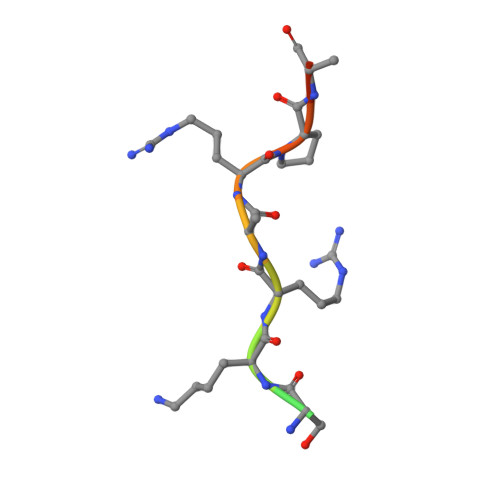Phosphorylation adjacent to the nuclear localization signal of human dUTPase abolishes nuclear import: structural and mechanistic insights.
Rona, G., Marfori, M., Borsos, M., Scheer, I., Takacs, E., Toth, J., Babos, F., Magyar, A., Erdei, A., Bozoky, Z., Buday, L., Kobe, B., Vertessy, B.G.(2013) Acta Crystallogr D Biol Crystallogr 69: 2495-2505
- PubMed: 24311590
- DOI: https://doi.org/10.1107/S0907444913023354
- Primary Citation of Related Structures:
4MZ5, 4MZ6 - PubMed Abstract:
Phosphorylation adjacent to nuclear localization signals (NLSs) is involved in the regulation of nucleocytoplasmic transport. The nuclear isoform of human dUTPase, an enzyme that is essential for genomic integrity, has been shown to be phosphorylated on a serine residue (Ser11) in the vicinity of its nuclear localization signal; however, the effect of this phosphorylation is not yet known. To investigate this issue, an integrated set of structural, molecular and cell biological methods were employed. It is shown that NLS-adjacent phosphorylation of dUTPase occurs during the M phase of the cell cycle. Comparison of the cellular distribution of wild-type dUTPase with those of hyperphosphorylation- and hypophosphorylation-mimicking mutants suggests that phosphorylation at Ser11 leads to the exclusion of dUTPase from the nucleus. Isothermal titration microcalorimetry and additional independent biophysical techniques show that the interaction between dUTPase and importin-α, the karyopherin molecule responsible for `classical' NLS binding, is weakened significantly in the case of the S11E hyperphosphorylation-mimicking mutant. The structures of the importin-α-wild-type and the importin-α-hyperphosphorylation-mimicking dUTPase NLS complexes provide structural insights into the molecular details of this regulation. The data indicate that the post-translational modification of dUTPase during the cell cycle may modulate the nuclear availability of this enzyme.
Organizational Affiliation:
Institute of Enzymology, RCNS, Hungarian Academy of Sciences, 1113 Budapest, Hungary.















